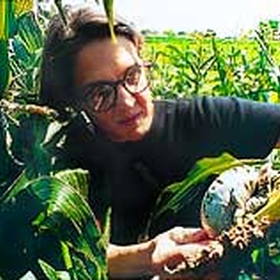

Georgiana
May
My lab investigates the genetic and molecular basis of plants' evolutionary interactions with other organisms, especially fungi.
Research statement
Plants sink their roots, stand firm, and duke out life surrounded by other organisms. Fungi, bacteria, viruses, insects, and other plants all have an impact on plant fitness and consequently, plants have evolved numerous mechanisms for controlling these interactions. One might think of each individual plant as a community itself with both external and internal symbionts. My lab investigates the genetic and molecular basis of plants' evolutionary interactions with other organisms, especially fungi. Projects include the evolutionary interactions between corn and the pathogenic smut fungus, evolution of resistance genes, and the role of genome rearrangement in pathogenesis. Our work encompasses a variety of approaches; field experiments and observations, systematics, genetics, and molecular biology. In addition, my and several of my students are actively involved in an interdisciplinary research group, Community Genetics.
Selected publications
May, G. and Munkasci, A. 2000. Recombination, rearrangement and selection, common themes in the evolution of self recognition genes. submitted to Heredity
May, G., Shaw, F., Badrane, H. and Vekemans, X. 1999. The signature of balancing selection: fungal mating genes. Proc. Natl. Acad. Sci. 96: 9172-9177
Natvig, D. O., and May, G. 1998. Invited Review: Fungal evolution and speciation. J. Genetics 75:441-452
Zambino, P., Groth, J. V., Lukens, L., Garton, J. R. and May, G. 1997. Variation at the b mating-type locus of Ustilago maydis. Phytopathology 87:1233-1239.
Rizzo, D. M., Blanchette, R. A. and May, G. 1995. Distribution of Armillaria ostoyae genets in a Pinus resinosa-P. banksiana forest Can. J. Bot: 73:776-787
May, G. and Matzke, E. 1995 Recombination and variation at the A mating-type locus of Coprinus cinereus., Mol. Biol. Evol. 12: 794-802
Education
Ph.D., University of California-Berkeley 1987